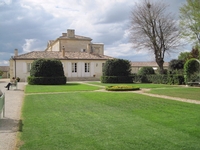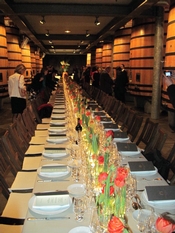These are the best of times for the vignerons of Burgundy and Bordeaux, arguably the world’s most important — certainly the most famous — vineyard lands.
Over the course of the past three weeks, I’ve had the rare opportunity to immerse myself in the wines of both regions, tasting all of the most recent vintages as well as a number of older wines, including a fair sampling from the controversial 2003 harvest.
As I reflect upon the experience, a few observations come quickly to mind.
 The Bordelaise have never had it so good. In my experience, the only stretch that compares to the run of good vintages in 2009, 2010 and 2011 is the outstanding trio of vintages from 1988 through 1990. The latter three were all very good, and 1988 will likely go down as one of the most underrated Bordeaux vintages of all time. But the current streak is much better than that because 2009 and 2010 are superior to 1989 and 1990. And despite all the hype over the vaunted 2009 vintage, in my humble opinion 2010 is even better.
The Bordelaise have never had it so good. In my experience, the only stretch that compares to the run of good vintages in 2009, 2010 and 2011 is the outstanding trio of vintages from 1988 through 1990. The latter three were all very good, and 1988 will likely go down as one of the most underrated Bordeaux vintages of all time. But the current streak is much better than that because 2009 and 2010 are superior to 1989 and 1990. And despite all the hype over the vaunted 2009 vintage, in my humble opinion 2010 is even better.
Although the quality in 2011 isn’t as even throughout the region as it was in 2009 and 2010, the wines from the top chateaux in the better districts are just as good. If you accept the evaluation that 2008 is a sleeper vintage, much better than advertised, then you could also point to a four-year run of high quality vintages that would be unprecedented in the history of Bordeaux.
The big issue in Bordeaux at the moment is pricing. The top wines are simply too expensive for the American market, except for those who purchase for investment purposes and intend to put their stocks on the auction market at some point. Driving the price ever higher is the recent and intense interest from the Chinese market. The Chinese also, to some extent, are playing a big role in the red-hot auction market, as well as the red-hot "after" market for older vintages of Bordeaux from the top chateaux. The fear is that Bordeaux will eventually lose the American market to equally fashionable but less expensive fine wines. No one wants to lose the American market, but the possibility is very real.
 The 2003 vintage was hailed as a "miracle" when the wines were first presented "en primeurs" during the spring of 2004. The miracle was that the Bordelaise had somehow survived the heat wave that gripped all of Europe in the summer of 2003, turning many of the grapes in the most famous vineyards into raisins. Turns out the kudos were both premature and flat-out undeserved. The 2003 Bordeaux are pretty much a disaster. The tannins, masked by uber-ripe fruit when young, are extremely coarse, and the wines lack elegance. You can drink them now, but you likely won’t enjoy them so much. But better now than a year or two from now. "No one had seen or experienced such a vintage," said Stephane Pariaud of Chateau Greysac in the Medoc. "Having been through it once, all of the chateaux would be better able to cope with such extreme heat, and would make better wine." Now they tell us.
The 2003 vintage was hailed as a "miracle" when the wines were first presented "en primeurs" during the spring of 2004. The miracle was that the Bordelaise had somehow survived the heat wave that gripped all of Europe in the summer of 2003, turning many of the grapes in the most famous vineyards into raisins. Turns out the kudos were both premature and flat-out undeserved. The 2003 Bordeaux are pretty much a disaster. The tannins, masked by uber-ripe fruit when young, are extremely coarse, and the wines lack elegance. You can drink them now, but you likely won’t enjoy them so much. But better now than a year or two from now. "No one had seen or experienced such a vintage," said Stephane Pariaud of Chateau Greysac in the Medoc. "Having been through it once, all of the chateaux would be better able to cope with such extreme heat, and would make better wine." Now they tell us.
Burgundy is riding the quality wave much as the producers and negociants are in Bordeaux, having experienced back-to-back outstanding harvests, though the 2009 vintage in Burgundy is not at the same level as the 2009 vintage in Bordeaux.
It was a warm year that produced generous, fleshy wines that have immediate drinkability and appeal. The whites are slightly lower in acid than normal and may not age as well as usual, but they are delicious now. The reds are riper and softer, too, and will be attractive to drink much earlier than usual.
The 2010 vintage, however, is a classic and rivals Bordeaux 2010 in quality. It will be a good year to load up on Bourgogne and village wines, for all sectors saw quality rise. For my cellar I am deeply interested in premier cru reds from the Cote de Nuits and premier cru whites from the Cote de Beaune. Unlike the top wines of Bordeaux, I can actually afford premier cru Burgundy.
Over the course of a week in Burgundy, I had the opportunity to taste a number of older vintages, both at professional trade tastings and while dining out. The 2007 vintage was everywhere, and now I understand why it has popped up on so many wine lists in and around Beaune. The 2007s have matured quickly and now exhibit advanced secondary aromas (tobacco, leather, mushrooms) that you might expect to find in much older wines. The wines from 2007 that I tasted were far from awful, but it was apparent they have already passed their peak and will not last. If you happen to have 2007 red Burgundy on your rack, you may want to think about consuming it sooner rather than later. As they say, "Drink up!"
8
